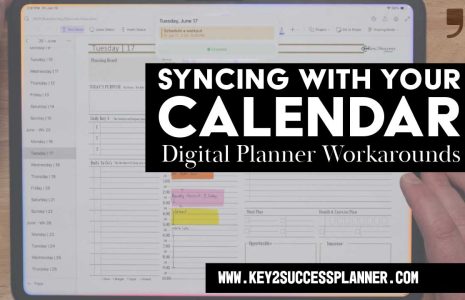How to Build a Habit: Tips & Tools
Wondering how to build a habit? How long does it take to build a habit? How a habit tracker or digital planner can help?
A habit is a behavior that becomes automatic over time through repetition. It is triggered by a specific context or cue in your environment, such as brushing your teeth after waking up or checking your phone when you hear a notification. Once established, a habit requires little conscious thought or effort, as your brain links the cue to the behavior. This allows you to perform the action almost instinctively.
In essence, habits help free up mental resources for other tasks by turning regular actions into routines. They are formed by consistently repeating a specific behavior in response to the same contextual cues, eventually becoming effortless and persistent.
Read on as we cover:
- How to build a habit.
- How long it takes to build a habit.
- Tools to help build a habit.
- How Digital planning can help build a habit (and stick with it!)
As always, we’re here to help on your digital planning journey! Reach out to our team today!
Visit the OneNote Planner Shop
Visit the GoodNotes/PDF Shop
Visit the Samsung Notes Shop
Visit the Nebo Shop
Visit the Penly Shop
Visit the Amazon Scribe Shop
Visit the reMarkable Shop
Visit the Onyx Boox Shop
Visit the Noteshelf Shop
How long does it take to build a habit?
The time it takes to build a habit can vary depending on the individual and the complexity of the habit, but research suggests it typically takes around 21 to 66 days to form a new habit. A study by University College London found that, on average, it takes 66 days for a behavior to become automatic. However, simpler habits might take less time, while more complex habits could take longer.
For example, the 21/90 rule states that it takes 21 days to make a habit and 90 days to make it a permanent lifestyle change. If you stick to your goal for 21 days, it will naturally become part of your everyday lifestyle.
The key is consistency. Repeating the behavior in a stable environment over time helps reinforce the habit, making it more likely to stick. While you may hear about the “21-day rule,” it’s important to remember that building lasting habits often requires patience and persistence.
According to James Clear, All habits proceed through four stages in the same order: cue, craving, response, and reward. This four-step pattern is the backbone of every habit, and your brain runs through these steps in the same order each time.
A study published in the British Journal of General Practice emphasizes the value of habit formation for long-term behavior change, particularly in health contexts. It explains that creating habits through repeated actions in consistent contexts is a powerful tool for making behaviors automatic and sustainable.
The idea is to move from conscious effort (“System 2” processes) to automatic responses (“System 1” processes) triggered by external cues, such as eating a piece of fruit after lunch. This approach is easier to follow than traditional behavior change strategies, which often rely heavily on motivation and attention, both of which wane over time.
Applying habit formation to digital planning can be just as impactful. By consistently using your digital planner at the same time every day, like during your morning routine or right before bed, you can automate the behavior of planning and reviewing your tasks.
Over time, the action of opening your planner becomes second nature, requiring little mental effort. This kind of automaticity ensures that planning and staying organized become effortless habits, which are more likely to stick long-term.
Visit the OneNote Planner Shop
Visit the GoodNotes/PDF Shop
Visit the Samsung Notes Shop
Visit the Nebo Shop
Visit the Penly Shop
Visit the Amazon Scribe Shop
Visit the reMarkable Shop
Visit the Onyx Boox Shop
Visit the Noteshelf Shop
How to Build a Habit Guide
Building a habit requires consistency, patience, and a clear plan of action. Here’s a step-by-step approach on how to build a habit that sticks:
Start Small: Begin by choosing a habit that is simple and easy to integrate into your daily routine. For example, if you want to exercise more, start with a 5-minute walk rather than committing to an hour-long workout. The key is to make it so manageable that you can’t make excuses not to do it.
Set a Trigger or Cue: Habits are often tied to specific triggers. A trigger could be a time of day, a particular place, or another routine activity. For example, you could link your habit of drinking more water to finishing a meal or set a reminder to journal right after waking up. The consistent association helps reinforce the new behavior.
Track Your Progress: Using tools like digital planners or habit-tracking apps allows you to visually monitor your progress. A visual cue of your daily wins motivates you to keep going and makes it easier to recognize your accomplishments over time.
Be Consistent: To successfully build a habit, repetition is key. Aim to practice your habit at the same time and place every day, so it starts to feel automatic. It can take anywhere from 21 to 66 days to form a habit, depending on the complexity, so being consistent during this period is crucial.
Reward Yourself: Positive reinforcement plays a huge role in how to build a habit successfully. Reward yourself after completing your new habit consistently for a week or a month. This could be something simple like a small treat or time for yourself, which further strengthens your motivation to keep going.
By following these steps, you can successfully build habits that contribute to long-term success, whether it’s personal growth, productivity, or better health.
A Habit Building Tool
A habit tracker is a tool designed to help you monitor and maintain your progress toward building new habits or breaking old ones. In a habit tracker, you typically record each time you complete a specific action or goal, giving you a visual record of your consistency over time. It serves as both a motivational tool and a reminder to stay on track.
In the Key2Success Digital Planner, the habit tracker is particularly useful for setting personal or professional goals. It allows you to define specific habits you want to develop, such as exercising, reading, or completing a work task, and then track your daily or weekly progress. By visually seeing how often you’ve successfully followed through, the habit tracker reinforces positive behavior, helping you stay committed until the habit becomes automatic.
Additionally, a habit tracker provides valuable insight into your patterns, helping you adjust your approach if you miss your goals. The Key2Success planner integrates the tracker seamlessly into your overall planning routine, encouraging long-term success.
Visit the OneNote Planner Shop
Visit the GoodNotes/PDF Shop
Visit the Samsung Notes Shop
Visit the Nebo Shop
Visit the Penly Shop
Visit the Amazon Scribe Shop
Visit the reMarkable Shop
Visit the Onyx Boox Shop
Visit the Noteshelf Shop
How to Succeed with Habit Tracking
Here’s an insightful breakdown of how to succeed with habit tracking, using tools like the Key2Success Digital Planner:
1. Understanding Habit Tracking Beyond Checkmarks
Traditional habit trackers often feel too simplistic, focusing on checking a box if you’ve completed a task, but offering little room for self-reflection. In the Key2Success Planner, habit tracking is more holistic. It encourages you to reflect on why you did or didn’t achieve a habit, allowing you to understand both your challenges and opportunities for growth.
2. Developing and Breaking Habits
Habit trackers aren’t just about building new habits; they’re also for breaking old ones. For example, in fitness, you may want to develop good habits like working out regularly or drinking more water, while also trying to break bad habits like late-night snacking or consuming too much soda. The Key2Success habit tracker allows you to focus on both aspects simultaneously, improving your overall lifestyle.
3. Setting Goals with Motivation
It’s essential to know why you’re aiming to develop or break a habit. What’s your end goal? In the Key2Success system, you start by identifying the reason behind each habit. Whether it’s to get healthier, achieve career goals, or improve personal relationships, having a clear goal provides motivation and direction.
4. Building Routines
Success in habit-building often depends on turning individual habits into a routine. By associating new habits with existing ones, like drinking water after every bathroom break, you integrate them into your daily life more naturally. This process-oriented approach is key to making habits stick.
5. Reflection and Self-Improvement
Reflection is a significant part of the Key2Success habit tracker. At the end of each week, you’re encouraged to reflect on your accomplishments and struggles. This self-awareness helps you make adjustments and refine your habits over time. You learn what’s working, what isn’t, and how to pivot for better success next week.
6. Customization and Flexibility
The tracker allows you to create separate habit lists for different areas of your life, such as fitness, education, or career development. You can also easily copy and reuse habits week by week, streamlining the process and ensuring consistency in tracking your progress.
7. Rewarding Yourself
Positive reinforcement is crucial for long-term habit success. The Key2Success system encourages you to reward yourself when you achieve significant milestones. Highlighting or celebrating specific habits you’ve nailed serves as motivation to keep going.
8. Multi-Platform Integration
The Key2Success planner works across various devices and apps, such as OneNote, GoodNotes, Notability, and even e-ink devices like reMarkable. This ensures you can access and track your habits on whichever platform works best for you, making your habit-tracking journey seamless, whether you’re on your phone, tablet, or digital notebook.
By focusing on reflection, goal-setting, flexibility, and self-reward, the Key2Success habit tracker elevates the traditional idea of habit tracking into a comprehensive system that drives personal growth.








